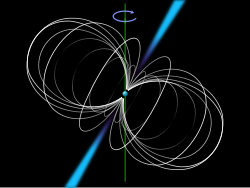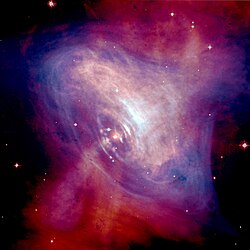Pulsar
It has been suggested that Radio pulsar be merged into this article. (Discuss) Proposed since March 2007. |
It has been suggested that X-ray pulsar be merged into this article. (Discuss) Proposed since March 2007. |



Pulsars are highly magnetized rotating neutron stars which emit a beam of detectable electromagnetic radiation in the form of radio waves. Their periods range from 1.5 ms to 8.5 s[1]. The radiation can only be observed when the beam of emission is pointing towards the Earth. This is called the lighthouse effect and gives rise to the pulsed nature that gives pulsars their name. Because neutron stars are very dense objects, the rotation period and thus the interval between observed pulses are very regular. For some pulsars the regularity of pulsation is as accurate as what can be achieved by an atomic clock.[2] Pulsars are known to have planets orbiting them, as in the case of PSR B1257+12. Werner Becker of the Max-Planck-Institut für extraterrestrische Physik recently said,
The theory of how pulsars emit their radiation is still in its infancy, even after nearly forty years of work."[3]
History
Discovery
Until recently, it was believed that the first pulsar had been observed on August 6th 1967, by Jocelyn Bell Burnell and Antony Hewish of the University of Cambridge, UK.[4] However in August 2007, a pre-discovery observing event was revealed during a symposium in Montreal, Canada.[5][6] Former military radar man Charles Schisler announced he has logs from his work on the Ballistic Missile Early Warning System at Clear Air Force Station, Alaska. While watching for any incoming nuclear missiles from Siberia, a pulse with a frequency of 1.3 seconds was observed that daily shifted for 4 minutes. At the university of Fairbanks, it was calculated that the source was within the Crab nebula, 6,300 lightyears away from earth. serveral months later, Bell Burnell and Hewish published their discovery of the same signal in Nature (# 217, 1968). Although the CLEAR-project has ended, Schisler did not seek permission to reveal his discovery, but since the cold war has ended, he sees no real problem with it 40 years later.[7]
Initially baffled as to the seemingly unnatural regularity of its emissions, Burnell and Hewish dubbed their discovery LGM-1, for "little green men" (a comical name for intelligent beings of extraterrestrial origin). Their pulsar was later dubbed CP 1919, and is now known by a number of designators including PSR 1919+21. Although the original choice of naming is indicative of the mystery surrounding the origin of the signals, according to Martin Rees, the hypothesis that they were beacons from extraterrestrial civilizations were never taken very seriously. However, astrophysicist Peter A. Sturrock writes that "when the first regular radio signals from pulsars were discovered, the Cambridge scientists seriously considered that they might have come from an extraterrestrial civilization. They debated this possibility and decided that, if this proved to be correct, they could not make an announcement without checking with higher authorities. There was even some discussion about whether it might be in the best interests of mankind to destroy the evidence and forget it!" (Sturrock, 154)
CP 1919 emits in radio wavelengths, but pulsars have subsequently been found to emit in the X-ray and/or gamma ray wavelengths.
The word pulsar is a contraction of "pulsating star", and first appeared in print in 1968:
"An entirely novel kind of star … came to light on Aug. 6 last year and … was referred to by astronomers as LGM (Little Green Men). Now … it is thought to be a novel type between a white dwarf and a neutron [sic]. The name Pulsar (Pulsating Star) is likely to be given to it. … Dr. A. Hewish … told me yesterday: '… I am sure that today every radio telescope is looking at the Pulsars.'"[8]
The suggestion that pulsars were rotating neutron stars was put forth independently by Thomas Gold and Franco Pacini in 1968, and was soon proven beyond doubt by the discovery of a pulsar with a very short 33-millisecond pulse period in the Crab nebula.
In 1974, Antony Hewish was awarded the Nobel Prize in physics, becoming the first astronomer to do so. Considerable controversy is associated with the fact that Professor Hewish was awarded the prize while Bell, who made the initial discovery while she was his Ph.D student, was not.
Subsequent history
In 1974, Joseph Taylor and Russell Hulse discovered for the first time a pulsar in a binary system, PSR B1913+16. This pulsar orbits another neutron star with an orbital period of just eight hours. Einstein's theory of general relativity predicts that this system should emit strong gravitational radiation, causing the orbit to continually contract as it loses orbital energy. Observations of the pulsar soon confirmed this prediction, providing the first ever evidence of the existence of gravitational waves. As of 2004, observations of this pulsar continue to agree with general relativity. In 1993 the Nobel prize in physics was awarded to Taylor and Hulse for the discovery of this pulsar.
In 1982, a pulsar with a rotation period of just 1.6 milliseconds was discovered, by Shri Kulkarni and Don Backer. Observations soon revealed that its magnetic field was much weaker than ordinary pulsars, while further discoveries cemented the idea that a new class of object, the "millisecond pulsars" (MSPs) had been found. MSPs are believed to be the end product of X-ray binaries. Owing to their extraordinarily rapid and stable rotation, MSPs can be used by astronomers as clocks rivalling the stability of the best atomic clocks on Earth. Factors affecting the arrival time of pulses at the Earth by more than a few hundred nanoseconds can be easily detected and used to make precise measurements. Physical parameters accessible through pulsar timing include the three-dimensional position of the pulsar, its proper motion, the electron content of the interstellar medium along the propagation path, the orbital parameters of any binary companion, the pulsar rotation period and its evolution with time. After these factors have been taken into account, deviations between the observed arrival times and predictions made using these parameters can be found and attributed to one of three possibilities: intrinsic variations in the spin period of the pulsar, errors in the realization of Terrestrial Time against which arrival times were measured, or the presence of background gravitational waves. Scientists are currently attempting to resolve these possibilities by comparing the deviations seen amongst several different pulsars, forming what is known as a Pulsar Timing Array. With luck, these efforts may lead to a time scale a factor of ten or more better than currently available, and the first ever direct detection of gravitational waves.
The first ever detected extrasolar planets were found orbiting a millisecond pulsar in 1990, by Aleksander Wolszczan. This discovery presented important evidence concerning the widespread existence of planets outside the solar system, although it is very unlikely that any life form could survive in the environment of intense radiation near a pulsar.
Pulsar classes
Three distinct classes of pulsars are currently known to astronomers, according to the source of energy that powers the radiation:
- Rotation-powered pulsars, where the loss of rotational energy of the star powers the radiation
- Accretion-powered pulsars (accounting for most but not all X-ray pulsars), where the gravitational potential energy of accreted matter is the energy source (producing X-rays that are observable from Earth), and
- Magnetars, where the decay of an extremely strong magnetic field powers the radiation.
Although all three classes of objects are neutron stars, their observable behaviour and the underlying physics are quite different. There are, however, connections. For example, X-ray pulsars are probably old rotation-powered pulsars that have already lost most of their energy, and have only become visible again after their binary companions expanded and began transferring matter on to the neutron star. The process of accretion can in turn transfer enough angular momentum to the neutron star to "recycle" it as a rotation-powered millisecond pulsar.
Glitch prediction
In June 2006, astronomer John Middleditch and his team at LANL announced the first prediction of glitches with observational data from the Rossi X-ray Timing Explorer. They used observations of the pulsar PSR J0537-6910.
Application
The study of pulsars has resulted in many applications in physics and astronomy. Striking examples include the confirmation of the existence of gravitational radiation as predicted by general relativity and the first detection of an extrasolar planetary system.
Significant pulsars
- The first radio pulsar, CP 1919 (now known as PSR 1919+21), with a pulse period of 1.337 seconds and a pulse width of 0.04 second, was discovered in 1967 (Nature 217:709-713, 1968). A drawing of this pulsar's radio waves was used as the cover of British rock band Joy Division's debut album, Unknown Pleasures.
- The first binary pulsar, PSR 1913+16, whose orbit is decaying at the exact rate predicted due to the emission of gravitational radiation by general relativity
- The first millisecond pulsar, PSR B1937+21
- The brightest millisecond pulsar, PSR J0437-4715
- The first X-ray pulsar, Cen X-3
- The first accreting millisecond X-ray pulsar, SAX J1808.4-3658
- The first extrasolar planets to be discovered orbit the pulsar PSR B1257+12
- The first double pulsar binary system, PSR J0737−3039
- The magnetar SGR 1806-20 produced the largest burst of energy in the Galaxy ever experimentally recorded on 27 December 2004
- PSR B1931+24 "... appears as a normal pulsar for about a week and then 'switches off' for about one month before emitting pulses again. [..] this pulsar slows down more rapidly when the pulsar is on than when it is off. [.. the] braking mechanism must be related to the radio emission and the processes creating it and the additional slow-down can be explained by a wind of particles leaving the pulsar's magnetosphere and carrying away rotational energy. [1]
- PSR J1748-2446ad, at 716 Hz, the pulsar with the highest rotation speed.
- PSR J0108-1431, the closest pulsar to the Earth. It lies in the direction of the constellation Cetus, at a distance of about 86 parsecs.
Notes
- ^ M.D. Young, R.N. Manchester and S. Johnston. "A radio pulsar with an 8.5-second period that challenges emission models." Nature, 400:848-849, 1999.
- ^ D.N. Matsakis, J.H. Taylor and T.M. Eubanks. "A statistic for describing pulsar and clock stabilities." A&A, 326:924-928, October 1997.
- ^ European Space Agency, press release, "Old pulsars still have new tricks to teach us", 26 July 2006
- ^ Hewish, A.; Bell, S. J.; Pilkington, J. D.; Scott, P. F.; Collins, R. A., "Observation of a Rapidly Pulsating Radio Source" (1968) Nature, Vol. 217, pp. 709
- ^ http://www.nature.com/news/2007/070820/full/448974a.html
- ^ http://www.ledevoir.com/2007/08/17/153677.html
- ^ http://www.nos.nl/nosjournaal/artikelen/2007/8/23/230807_charles_gisler.html
- ^ Daily Telegraph 5 Mar 1968 21/3
Sources
- Duncan R. Lorimer, "Binary and Millisecond Pulsars at the New Millennium", Living Rev. Relativity 4, (2001), http://www.livingreviews.org/lrr-2001-5
- D. R. Lorimer & M. Kramer; Handbook of Pulsar Astronomy; Cambridge Observing Handbooks for Research Astronomers, 2004
- Ingrid H. Stairs, "Testing General Relativity with Pulsar Timing", Living Rev. Relativity 6, (2003): http://www.livingreviews.org/lrr-2003-5
- Peter A. Sturrock; The UFO Enigma: A New Review of the Physical Evidence; Warner Books, 1999; ISBN 0-446-52565-0
External links
- Pulsar
- A Pulsar Discovery - the detection of the first optical pulsar from the American Institute of Physics. Includes audio and teachers guides.
- The Discovery of Pulsars on H2G2
- Interview with Jocelyn Bell-Burnell on the discovery of pulsars (Jodcast) June, 2007 low quality version available
- The listing for the first pulsar (PULS CP 1919) in the Simbad database
- The ATNF Pulsar Catalogue
- Scientists Can Predict Pulsar Starquakes (SpaceDaily) Jun 07, 2006
- List of pulsars in binary systems
- XMM-Newton Makes New Discoveries About Old Pulsars (SpaceDaily) Jul 27, 2006
- Hot New Idea: How Dead Stars Go Cold Ker Than (SPACE.com) 27 July 2006 06:16 am ET
